2024
|
 | Šamajová, Veronika; Marešová, Jana; Majdák, Andrej; Jakuš, Rastislav; Blaženec, Miroslav The spruce bark volatiles and internal phloem chemical profiles after the forest gap formation: the annual course Journal Article Folia Oecologica, 51 (2), pp. 165–174, 2024, ISSN: 1338-7014. Abstract | Links | BibTeX @article{_amajov__2024,
title = {The spruce bark volatiles and internal phloem chemical profiles after the forest gap formation: the annual course},
author = {Veronika Šamajová and Jana Marešová and Andrej Majdák and Rastislav Jakuš and Miroslav Blaženec},
url = {http://ife.sk/wp-content/uploads/2020/09/foecol-2024-0016.pdf},
doi = {10.2478/foecol-2024-0016},
issn = {1338-7014},
year = {2024},
date = {2024-07-01},
journal = {Folia Oecologica},
volume = {51},
number = {2},
pages = {165–174},
publisher = {Walter de Gruyter GmbH},
abstract = {Our study explores the impact of sudden gap formation on the bark volatile and internal chemical profiles of Norway spruce trees during the initial dry year of research plot 2018 following gap formation. We investigated the annual variation in two main physiological traits of Norway spruce trees at the forest edge (FE) and in the forest interior (FI): bark monoterpene (MT) emission spectra and internal phloem MT composition. Given that gap formation increases the solar radiation dose and temperature for trees at the forest edge, we hypothesized that the concentrations of airborne terpenes released from the tree bark and internal phloem terpenes will increase as a consequence of induced tree defenses. Our findings demonstrate significant increases in both airborne terpene concentrations and internal terpene composition in trees at the forest edge compared to the control trees in the forest interior. This study provides novel insights into the annual dynamics of bark monoterpenes following forest edge establishment and underscores the physiological changes experienced by trees in response to the gap formation.},
keywords = {},
pubstate = {published},
tppubtype = {article}
}
Our study explores the impact of sudden gap formation on the bark volatile and internal chemical profiles of Norway spruce trees during the initial dry year of research plot 2018 following gap formation. We investigated the annual variation in two main physiological traits of Norway spruce trees at the forest edge (FE) and in the forest interior (FI): bark monoterpene (MT) emission spectra and internal phloem MT composition. Given that gap formation increases the solar radiation dose and temperature for trees at the forest edge, we hypothesized that the concentrations of airborne terpenes released from the tree bark and internal phloem terpenes will increase as a consequence of induced tree defenses. Our findings demonstrate significant increases in both airborne terpene concentrations and internal terpene composition in trees at the forest edge compared to the control trees in the forest interior. This study provides novel insights into the annual dynamics of bark monoterpenes following forest edge establishment and underscores the physiological changes experienced by trees in response to the gap formation. |
2023
|
 | Korecký, Jiří; Čepl, Jaroslav; Korolyova, Nataliya; Stejskal, Jan; Turčáni, Marek; Jakuš, Rastislav Resistance to Bark Beetle Outbreak in Norway Spruce: Population Structure Analysis and Comparative Genomic Assessment of Surviving (LTS) and Randomly Selected Reference Trees Journal Article Forests, 14 (10), pp. 2074, 2023, ISSN: 1999-4907. Links | BibTeX @article{Koreck__2023,
title = {Resistance to Bark Beetle Outbreak in Norway Spruce: Population Structure Analysis and Comparative Genomic Assessment of Surviving (LTS) and Randomly Selected Reference Trees},
author = {Jiří Korecký and Jaroslav Čepl and Nataliya Korolyova and Jan Stejskal and Marek Turčáni and Rastislav Jakuš},
url = {http://dx.doi.org/10.3390/f14102074},
doi = {10.3390/f14102074},
issn = {1999-4907},
year = {2023},
date = {2023-10-01},
journal = {Forests},
volume = {14},
number = {10},
pages = {2074},
publisher = {MDPI AG},
keywords = {},
pubstate = {published},
tppubtype = {article}
}
|
 | Kozhoridze, Giorgi; Korolyova, Nataliya; Jakuš, Rastislav Norway spruce susceptibility to bark beetles is associated with increased canopy surface temperature in a year prior disturbance Journal Article Forest Ecology and Management, 547 , pp. 121400, 2023, ISSN: 0378-1127. Links | BibTeX @article{Kozhoridze_2023,
title = {Norway spruce susceptibility to bark beetles is associated with increased canopy surface temperature in a year prior disturbance},
author = {Giorgi Kozhoridze and Nataliya Korolyova and Rastislav Jakuš},
url = {http://dx.doi.org/10.1016/j.foreco.2023.121400},
doi = {10.1016/j.foreco.2023.121400},
issn = {0378-1127},
year = {2023},
date = {2023-01-01},
journal = {Forest Ecology and Management},
volume = {547},
pages = {121400},
publisher = {Elsevier BV},
keywords = {},
pubstate = {published},
tppubtype = {article}
}
|
 | Moliterno, Antonioni Acacio Campos; Jakuš, Rastislav; Modlinger, Roman; Unelius, Rikard C; Schlyter, Fredrik; Jirošová, Anna Field effects of oxygenated monoterpenes and estragole combined with pheromone on attraction of Ips typographus and its natural enemies Journal Article Frontiers in Forests and Global Change, 6 , 2023, ISSN: 2624-893X. Links | BibTeX @article{Moliterno_2023,
title = {Field effects of oxygenated monoterpenes and estragole combined with pheromone on attraction of Ips typographus and its natural enemies},
author = {Antonioni Acacio Campos Moliterno and Rastislav Jakuš and Roman Modlinger and Rikard C Unelius and Fredrik Schlyter and Anna Jirošová},
url = {http://dx.doi.org/10.3389/ffgc.2023.1292581},
doi = {10.3389/ffgc.2023.1292581},
issn = {2624-893X},
year = {2023},
date = {2023-01-01},
journal = {Frontiers in Forests and Global Change},
volume = {6},
publisher = {Frontiers Media SA},
keywords = {},
pubstate = {published},
tppubtype = {article}
}
|
 | Trubin, Aleksei; Kozhoridze, Giorgi; Zabihi, Khodabakhsh; Modlinger, Roman; Singh, Vivek Vikram; Surový, Peter; Jakuš, Rastislav Detection of susceptible Norway spruce to bark beetle attack using PlanetScope multispectral imagery Journal Article Frontiers in Forests and Global Change, 6 , 2023, ISSN: 2624-893X. Links | BibTeX @article{Trubin_2023,
title = {Detection of susceptible Norway spruce to bark beetle attack using PlanetScope multispectral imagery},
author = {Aleksei Trubin and Giorgi Kozhoridze and Khodabakhsh Zabihi and Roman Modlinger and Vivek Vikram Singh and Peter Surový and Rastislav Jakuš},
url = {http://dx.doi.org/10.3389/ffgc.2023.1130721},
doi = {10.3389/ffgc.2023.1130721},
issn = {2624-893X},
year = {2023},
date = {2023-01-01},
journal = {Frontiers in Forests and Global Change},
volume = {6},
publisher = {Frontiers Media SA},
keywords = {},
pubstate = {published},
tppubtype = {article}
}
|
2022
|
 | Potterf, Mária; Svitok, Marek; Mezei, Pavel; Jarčuška, Benjamín; Jakuš, Rastislav; Blaženec, Miroslav; Hlásny, Tomáš Contrasting Norway spruce disturbance dynamics in managed forests and strict forest reserves in Slovakia Journal Article Forestry, 96 (3), pp. 387–398, 2022, ISSN: 1464-3626. Links | BibTeX @article{Potterf_2022,
title = {Contrasting Norway spruce disturbance dynamics in managed forests and strict forest reserves in Slovakia},
author = {Mária Potterf and Marek Svitok and Pavel Mezei and Benjamín Jarčuška and Rastislav Jakuš and Miroslav Blaženec and Tomáš Hlásny},
editor = {Dominik Thom},
url = {http://dx.doi.org/10.1093/forestry/cpac045},
doi = {10.1093/forestry/cpac045},
issn = {1464-3626},
year = {2022},
date = {2022-11-01},
journal = {Forestry},
volume = {96},
number = {3},
pages = {387–398},
publisher = {Oxford University Press (OUP)},
keywords = {},
pubstate = {published},
tppubtype = {article}
}
|
 | Trubin, Aleksei; Mezei, Pavel; Zabihi, Khodabakhsh; Surový, Peter; Jakuš, Rastislav Northernmost European spruce bark beetle Ips typographus outbreak: Modelling tree mortality using remote sensing and climate data Journal Article Forest Ecology and Management, 505 , pp. 119829, 2022, ISSN: 0378-1127. Links | BibTeX @article{Trubin_2022,
title = {Northernmost European spruce bark beetle Ips typographus outbreak: Modelling tree mortality using remote sensing and climate data},
author = {Aleksei Trubin and Pavel Mezei and Khodabakhsh Zabihi and Peter Surový and Rastislav Jakuš},
url = {http://dx.doi.org/10.1016/j.foreco.2021.119829},
doi = {10.1016/j.foreco.2021.119829},
issn = {0378-1127},
year = {2022},
date = {2022-02-01},
journal = {Forest Ecology and Management},
volume = {505},
pages = {119829},
publisher = {Elsevier BV},
keywords = {},
pubstate = {published},
tppubtype = {article}
}
|
 | Duduman, Mihai-Leonard; Beránková, Kateřina; Jakuš, Rastislav; Hradecký, Jaromír; Jirošová, Anna Efficiency and Sustainability of Ips duplicatus (Coleoptera: Curculionidae) Pheromone Dispensers with Different Designs Journal Article Forests, 13 (4), pp. 511, 2022, ISSN: 1999-4907. Links | BibTeX @article{Duduman_2022,
title = {Efficiency and Sustainability of Ips duplicatus (Coleoptera: Curculionidae) Pheromone Dispensers with Different Designs},
author = {Mihai-Leonard Duduman and Kateřina Beránková and Rastislav Jakuš and Jaromír Hradecký and Anna Jirošová},
url = {http://dx.doi.org/10.3390/f13040511},
doi = {10.3390/f13040511},
issn = {1999-4907},
year = {2022},
date = {2022-01-01},
journal = {Forests},
volume = {13},
number = {4},
pages = {511},
publisher = {MDPI AG},
keywords = {},
pubstate = {published},
tppubtype = {article}
}
|
 | Jakuš, Rastislav; Modlinger, Roman; Kašpar, Jaroslav; Majdák, Andrej; Blaženec, Miroslav; Korolyova, Nataliya; Jirošová, Anna; Schlyter, Fredrik Testing the Efficiency of the Push-and-Pull Strategy during Severe Ips typographus Outbreak and Extreme Drought in Norway Spruce Stands Journal Article Forests, 13 (12), pp. 2175, 2022, ISSN: 1999-4907. Links | BibTeX @article{Jaku__2022,
title = {Testing the Efficiency of the Push-and-Pull Strategy during Severe Ips typographus Outbreak and Extreme Drought in Norway Spruce Stands},
author = {Rastislav Jakuš and Roman Modlinger and Jaroslav Kašpar and Andrej Majdák and Miroslav Blaženec and Nataliya Korolyova and Anna Jirošová and Fredrik Schlyter},
url = {http://dx.doi.org/10.3390/f13122175},
doi = {10.3390/f13122175},
issn = {1999-4907},
year = {2022},
date = {2022-01-01},
journal = {Forests},
volume = {13},
number = {12},
pages = {2175},
publisher = {MDPI AG},
keywords = {},
pubstate = {published},
tppubtype = {article}
}
|
 | Jirošová, Anna; Kalinová, Blanka; Modlinger, Roman; Jakuš, Rastislav; Unelius, Rikard C; Blaženec, Miroslav; Schlyter, Fredrik Anti‐attractant activity of (+)‐trans‐4‐thujanol for Eurasian spruce bark beetle Ips typographus: Novel potency for females Journal Article Pest Management Science, 78 (5), pp. 1992–1999, 2022, ISSN: 1526-4998. Links | BibTeX @article{Jiro_ov__2022,
title = {Anti‐attractant activity of (+)‐trans‐4‐thujanol for Eurasian spruce bark beetle Ips typographus: Novel potency for females},
author = {Anna Jirošová and Blanka Kalinová and Roman Modlinger and Rastislav Jakuš and Rikard C Unelius and Miroslav Blaženec and Fredrik Schlyter},
url = {http://dx.doi.org/10.1002/ps.6819},
doi = {10.1002/ps.6819},
issn = {1526-4998},
year = {2022},
date = {2022-01-01},
journal = {Pest Management Science},
volume = {78},
number = {5},
pages = {1992–1999},
publisher = {Wiley},
keywords = {},
pubstate = {published},
tppubtype = {article}
}
|
 | Korolyova, Nataliya; Buechling, Arne; Lieutier, François; Yart, Annie; Cudlín, Pavel; Turčáni, Marek; Jakuš, Rastislav Primary and secondary host selection by Ips typographus depends on Norway spruce crown characteristics and phenolic-based defenses Journal Article Plant Science, 321 , pp. 111319, 2022, ISSN: 0168-9452. Links | BibTeX @article{Korolyova_2022,
title = {Primary and secondary host selection by Ips typographus depends on Norway spruce crown characteristics and phenolic-based defenses},
author = {Nataliya Korolyova and Arne Buechling and François Lieutier and Annie Yart and Pavel Cudlín and Marek Turčáni and Rastislav Jakuš},
url = {http://dx.doi.org/10.1016/j.plantsci.2022.111319},
doi = {10.1016/j.plantsci.2022.111319},
issn = {0168-9452},
year = {2022},
date = {2022-01-01},
journal = {Plant Science},
volume = {321},
pages = {111319},
publisher = {Elsevier BV},
keywords = {},
pubstate = {published},
tppubtype = {article}
}
|
 | Korolyova, Nataliya; Buechling, Arne; Ďuračiová, Renata; Zabihi, Khodabakhsh; Turčáni, Marek; Svoboda, Miroslav; Bláha, Jaromír; Swarts, Kelly; Poláček, Miroslav; Hradecký, Jaromir; Červenka, Jaroslav; Němčák, Pavel; Schlyter, Fredrik; Jakuš, Rastislav The Last Trees Standing: Climate modulates tree survival factors during a prolonged bark beetle outbreak in Europe Journal Article Agricultural and Forest Meteorology, 322 , pp. 109025, 2022, ISSN: 0168-1923. Links | BibTeX @article{Korolyova_2022b,
title = {The Last Trees Standing: Climate modulates tree survival factors during a prolonged bark beetle outbreak in Europe},
author = {Nataliya Korolyova and Arne Buechling and Renata Ďuračiová and Khodabakhsh Zabihi and Marek Turčáni and Miroslav Svoboda and Jaromír Bláha and Kelly Swarts and Miroslav Poláček and Jaromir Hradecký and Jaroslav Červenka and Pavel Němčák and Fredrik Schlyter and Rastislav Jakuš},
url = {http://dx.doi.org/10.1016/j.agrformet.2022.109025},
doi = {10.1016/j.agrformet.2022.109025},
issn = {0168-1923},
year = {2022},
date = {2022-01-01},
journal = {Agricultural and Forest Meteorology},
volume = {322},
pages = {109025},
publisher = {Elsevier BV},
keywords = {},
pubstate = {published},
tppubtype = {article}
}
|
 | Soukhovolsky, Vladislav; Kovalev, Anton; Tarasova, Olga; Modlinger, Roman; Křenová, Zdenka; Mezei, Pavel; Škvarenina, Jaroslav; Rožnovský, Jaroslav; Korolyova, Nataliya; Majdák, Andrej; Jakuš, Rastislav Wind Damage and Temperature Effect on Tree Mortality Caused by Ips typographus L.: Phase Transition Model Journal Article Forests, 13 (2), pp. 180, 2022, ISSN: 1999-4907. Links | BibTeX @article{Soukhovolsky_2022,
title = {Wind Damage and Temperature Effect on Tree Mortality Caused by Ips typographus L.: Phase Transition Model},
author = {Vladislav Soukhovolsky and Anton Kovalev and Olga Tarasova and Roman Modlinger and Zdenka Křenová and Pavel Mezei and Jaroslav Škvarenina and Jaroslav Rožnovský and Nataliya Korolyova and Andrej Majdák and Rastislav Jakuš},
url = {http://dx.doi.org/10.3390/f13020180},
doi = {10.3390/f13020180},
issn = {1999-4907},
year = {2022},
date = {2022-01-01},
journal = {Forests},
volume = {13},
number = {2},
pages = {180},
publisher = {MDPI AG},
keywords = {},
pubstate = {published},
tppubtype = {article}
}
|
 | Stříbrská, Barbora; Hradecký, Jaromír; Čepl, Jaroslav; Tomášková, Ivana; Jakuš, Rastislav; Modlinger, Roman; Netherer, Sigrid; Jirošová, Anna Forest margins provide favourable microclimatic niches to swarming bark beetles, but Norway spruce trees were not attacked by Ips typographus shortly after edge creation in a field experiment Journal Article Forest Ecology and Management, 506 , pp. 119950, 2022, ISSN: 0378-1127. Links | BibTeX @article{St_brsk__2022,
title = {Forest margins provide favourable microclimatic niches to swarming bark beetles, but Norway spruce trees were not attacked by Ips typographus shortly after edge creation in a field experiment},
author = {Barbora Stříbrská and Jaromír Hradecký and Jaroslav Čepl and Ivana Tomášková and Rastislav Jakuš and Roman Modlinger and Sigrid Netherer and Anna Jirošová},
url = {http://dx.doi.org/10.1016/j.foreco.2021.119950},
doi = {10.1016/j.foreco.2021.119950},
issn = {0378-1127},
year = {2022},
date = {2022-01-01},
journal = {Forest Ecology and Management},
volume = {506},
pages = {119950},
publisher = {Elsevier BV},
keywords = {},
pubstate = {published},
tppubtype = {article}
}
|
2021
|
 | Zabihi, Khodabakhsh; Surovy, Peter; Trubin, Aleksei; Singh, Vivek Vikram; Jakuš, Rastislav A review of major factors influencing the accuracy of mapping green-attack stage of bark beetle infestations using satellite imagery: Prospects to avoid data redundancy Journal Article Remote Sensing Applications: Society and Environment, 24 , pp. 100638, 2021, ISSN: 2352-9385. Links | BibTeX @article{Zabihi_2021,
title = {A review of major factors influencing the accuracy of mapping green-attack stage of bark beetle infestations using satellite imagery: Prospects to avoid data redundancy},
author = {Khodabakhsh Zabihi and Peter Surovy and Aleksei Trubin and Vivek Vikram Singh and Rastislav Jakuš},
url = {http://dx.doi.org/10.1016/j.rsase.2021.100638},
doi = {10.1016/j.rsase.2021.100638},
issn = {2352-9385},
year = {2021},
date = {2021-11-01},
journal = {Remote Sensing Applications: Society and Environment},
volume = {24},
pages = {100638},
publisher = {Elsevier BV},
keywords = {},
pubstate = {published},
tppubtype = {article}
}
|
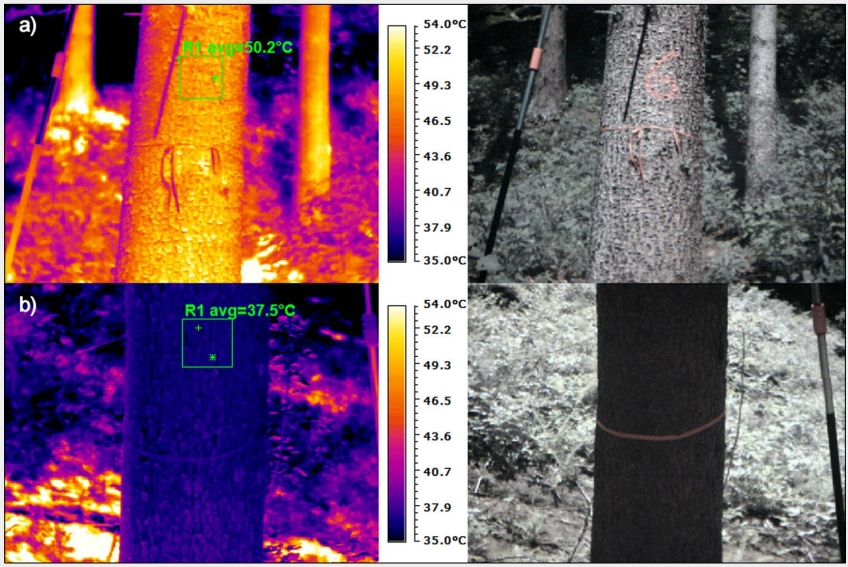 | Majdák, Andrej; Jakuš, Rastislav; Blaženec, Miroslav Determination of differences in temperature regimes on healthy and bark-beetle colonised spruce trees using a handheld thermal camera Journal Article iFOREST, 14 , pp. 203-211, 2021, ISSN: 1971-7458. Abstract | Links | BibTeX @article{Majdák2021,
title = {Determination of differences in temperature regimes on healthy and bark-beetle colonised spruce trees using a handheld thermal camera},
author = {Andrej Majdák and Rastislav Jakuš and Miroslav Blaženec},
doi = {https://doi.org/10.3832/ifor3531-014},
issn = {1971-7458},
year = {2021},
date = {2021-05-02},
journal = {iFOREST},
volume = {14},
pages = {203-211},
abstract = {In this study, we compared the daily temperature regimes of healthy uninfected trees in the interior of a forest stand and at the fresh forest edge with infested trees at the forest edge in an area affected by a bark beetle outbreak. We estimated the potential of a handheld thermal camera for early identification of bark-beetle infested trees. We show that infested trees have significantly higher trunk temperatures than uninfested trees, which is more visible on the shine side of the trunk, and we report the differences in temperature between the shine and shadow sides. The differences are more noticeable on a warm, bright, and sunny day than on cold and cloudy day. The different intensity of solar radiation does not affect the distinction between infested and uninfested trees. The handheld thermal camera shows potential for identifying bark-beetle infested trees by scanning tree trunks on bright sunny days.},
keywords = {},
pubstate = {published},
tppubtype = {article}
}
In this study, we compared the daily temperature regimes of healthy uninfected trees in the interior of a forest stand and at the fresh forest edge with infested trees at the forest edge in an area affected by a bark beetle outbreak. We estimated the potential of a handheld thermal camera for early identification of bark-beetle infested trees. We show that infested trees have significantly higher trunk temperatures than uninfested trees, which is more visible on the shine side of the trunk, and we report the differences in temperature between the shine and shadow sides. The differences are more noticeable on a warm, bright, and sunny day than on cold and cloudy day. The different intensity of solar radiation does not affect the distinction between infested and uninfested trees. The handheld thermal camera shows potential for identifying bark-beetle infested trees by scanning tree trunks on bright sunny days. |
 | Koreň, Milan; Jakuš, Rastislav; Zápotocký, Martin; Barka, Ivan; Holuša, Jaroslav; Ďuračiová, Renata; Blaženec, Miroslav Assessment of Machine Learning Algorithms for Modeling the Spatial Distribution of Bark Beetle Infestation Journal Article Forests, 12 (4), pp. 395, 2021, ISSN: 1999-4907. Links | BibTeX @article{Kore__2021,
title = {Assessment of Machine Learning Algorithms for Modeling the Spatial Distribution of Bark Beetle Infestation},
author = {Milan Koreň and Rastislav Jakuš and Martin Zápotocký and Ivan Barka and Jaroslav Holuša and Renata Ďuračiová and Miroslav Blaženec},
url = {http://dx.doi.org/10.3390/f12040395},
doi = {10.3390/f12040395},
issn = {1999-4907},
year = {2021},
date = {2021-01-01},
journal = {Forests},
volume = {12},
number = {4},
pages = {395},
publisher = {MDPI AG},
keywords = {},
pubstate = {published},
tppubtype = {article}
}
|
2020
|
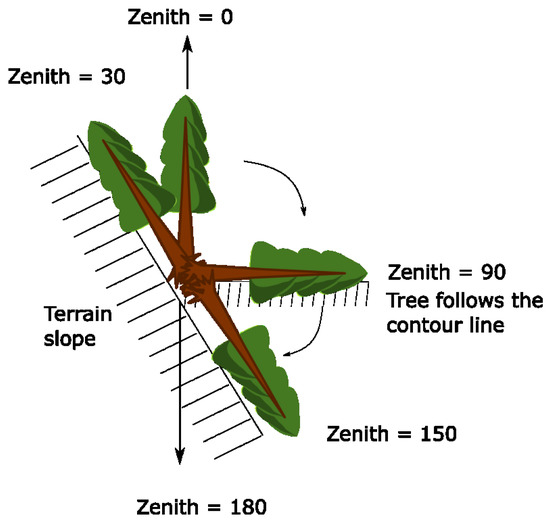 | Hroššo, Branislav; Mezei, Pavel; Potterf, Mária; Majdák, Andrej; Blaženec, Miroslav; Korolyova, Nataliya; Jakuš, Rastislav Drivers of Spruce Bark Beetle (Ips typographus) Infestations on Downed Trees after Severe Windthrow Journal Article Forests, 11 , 2020, ISSN: 1999-4907. Abstract | Links | BibTeX @article{Hroššo2020,
title = {Drivers of Spruce Bark Beetle (\textit{Ips typographus}) Infestations on Downed Trees after Severe Windthrow},
author = {Branislav Hroššo and Pavel Mezei and Mária Potterf and Andrej Majdák and Miroslav Blaženec and Nataliya Korolyova and Rastislav Jakuš},
doi = {10.3390/f11121290},
issn = {1999-4907},
year = {2020},
date = {2020-11-30},
journal = {Forests},
volume = {11},
abstract = {Research Highlights: Bark beetles are important agents of disturbance regimes in temperate forests, and specifically in a connected wind-bark beetle disturbance system. Large-scale windthrows trigger population growth of the European spruce bark beetle (Ips typographus L.) from endemic to epidemic levels, thereby allowing the killing of Norway spruce trees over several consecutive years. Background and Objectives: There is a lack of evidence to differentiate how outbreaks are promoted by the effects of environmental variables versus beetle preferences of trees from endemic to outbreak. However, little is known about how individual downed-tree characteristics and local conditions such as tree orientation and solar radiation affect beetle colonization of downed trees. Materials and Methods: To answer this question, we investigated the infestation rates and determined tree death categories (uprooted, broken, and stump) in wind-damaged areas in Western Tatra Mts. in Carpathians (Slovakia) from 2014–2016, following a windthrow in May 2014. In total, we investigated 225 trees over eight transects. For every tree, we measured its morphological (tree height, crown characteristics), environmental (solar radiation, terrain conditions, trunk zenith), temporal (time since wind damage), and beetle infestation (presence, location of attack, bark desiccation) parameters. We applied Generalized Additive Mixed Models (GAMM) to unravel the main drivers of I. typographus infestations. Results: Over the first year, beetles preferred to attack broken trees and sun-exposed trunk sides over uprooted trees; the infestation on shaded sides started in the second year along with the infestation of uprooted trees with lower desiccation rates. We found that time since wind damage, stem length, and incident solar radiation increased the probability of beetle infestation, although both solar radiation and trunk zenith exhibited nonlinear variability. Our novel variable trunk zenith appeared to be an important predictor of bark beetle infestation probability. We conclude that trunk zenith as a simple measure defining the position of downed trees over the terrain can anticipate beetle infestation. Conclusions: Our findings contribute to understanding of the bark beetle’s preferences to colonize windthrown trees in the initial years after the primary wind damage. Further, our findings can help to identify trees that are most susceptible to beetle infestation and to prioritize management actions to control beetle population while maintaining biodiversity.},
keywords = {},
pubstate = {published},
tppubtype = {article}
}
Research Highlights: Bark beetles are important agents of disturbance regimes in temperate forests, and specifically in a connected wind-bark beetle disturbance system. Large-scale windthrows trigger population growth of the European spruce bark beetle (Ips typographus L.) from endemic to epidemic levels, thereby allowing the killing of Norway spruce trees over several consecutive years. Background and Objectives: There is a lack of evidence to differentiate how outbreaks are promoted by the effects of environmental variables versus beetle preferences of trees from endemic to outbreak. However, little is known about how individual downed-tree characteristics and local conditions such as tree orientation and solar radiation affect beetle colonization of downed trees. Materials and Methods: To answer this question, we investigated the infestation rates and determined tree death categories (uprooted, broken, and stump) in wind-damaged areas in Western Tatra Mts. in Carpathians (Slovakia) from 2014–2016, following a windthrow in May 2014. In total, we investigated 225 trees over eight transects. For every tree, we measured its morphological (tree height, crown characteristics), environmental (solar radiation, terrain conditions, trunk zenith), temporal (time since wind damage), and beetle infestation (presence, location of attack, bark desiccation) parameters. We applied Generalized Additive Mixed Models (GAMM) to unravel the main drivers of I. typographus infestations. Results: Over the first year, beetles preferred to attack broken trees and sun-exposed trunk sides over uprooted trees; the infestation on shaded sides started in the second year along with the infestation of uprooted trees with lower desiccation rates. We found that time since wind damage, stem length, and incident solar radiation increased the probability of beetle infestation, although both solar radiation and trunk zenith exhibited nonlinear variability. Our novel variable trunk zenith appeared to be an important predictor of bark beetle infestation probability. We conclude that trunk zenith as a simple measure defining the position of downed trees over the terrain can anticipate beetle infestation. Conclusions: Our findings contribute to understanding of the bark beetle’s preferences to colonize windthrown trees in the initial years after the primary wind damage. Further, our findings can help to identify trees that are most susceptible to beetle infestation and to prioritize management actions to control beetle population while maintaining biodiversity. |
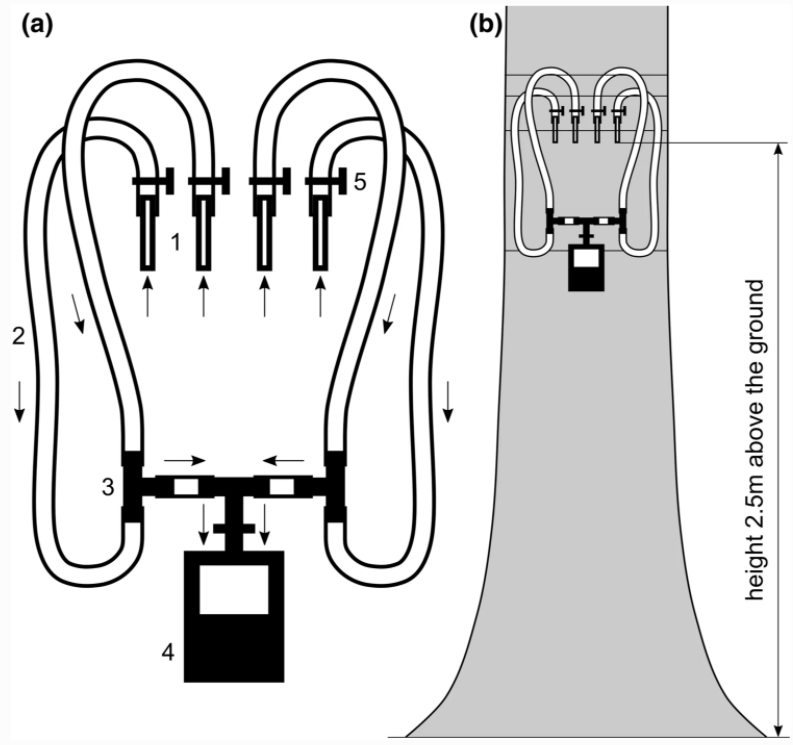 | Marešová, Jana; Majdák, Andrej; Jakuš, Rastislav; Hradecký, Jaromír; Kalinová, Blanka; Blaženec, Miroslav The short-term effect of sudden gap creation on tree temperature and volatile composition profiles in a Norway spruce stand Journal Article Trees-Structure and Function, 34 (6), pp. 1397–1409, 2020, ISSN: 0931-1890. Abstract | Links | BibTeX @article{Marešová2020,
title = {The short-term effect of sudden gap creation on tree temperature and volatile composition profiles in a Norway spruce stand},
author = {Jana Marešová and Andrej Majdák and Rastislav Jakuš and Jaromír Hradecký and Blanka Kalinová and Miroslav Blaženec},
doi = {10.1007/s00468-020-02010-w},
issn = {0931-1890},
year = {2020},
date = {2020-08-05},
journal = {Trees-Structure and Function},
volume = {34},
number = {6},
pages = {1397–1409},
abstract = {Spruce bark beetles are likely to attack trees that are at newly opened forest edges after wind disturbance due to higher temperatures and higher emission of primary attractants. The mechanisms behind these phenomena are still not fully known. We investigated how sudden gap creation affects tree physiology parameters related to induced defence processes in Norway spruce trees 2 months after the disturbance driven gap formation. We hypothesized that the sudden sun exposure of mature spruce trees would increase: (1) bark and crown temperatures, (2) sap flow rates, and (3) the phloem and airborne concentration of terpenes. Using a terrestrial and airborne thermal camera, sap flow sensors, and chromatography, we confirmed that trees at the forest edge had significantly higher (1) mean tree crown temperature, (2) mean sap flow rates (2-fold higher) and (3) airborne concentration of α-pinene (αP, 12.2-fold higher) and β-pinene (βP, 7.9-fold higher) close to the bark. We observed a significant positive correlation (R2 = 0.77) between the measured sap flow rates and terpene concentrations in airborne samples. Bark temperatures were not significant. In the phloem samples, analyzed by GC–MS, αP and βP predominated over monoterpenes 3-carene, myrcene, limonene, 1.8-cineole, and bornyl acetate. GC × GC–TOF–MS analysis of phloem showed a higher relative abundance of resin acid methyl esters in the forest interior trees and higher relative abundances of dehydro-p-cymene in the trees at the forest edge. Our findings are discussed in the context of the enhanced predisposition of trees at the newly formed forest edge to bark beetles attack.},
keywords = {},
pubstate = {published},
tppubtype = {article}
}
Spruce bark beetles are likely to attack trees that are at newly opened forest edges after wind disturbance due to higher temperatures and higher emission of primary attractants. The mechanisms behind these phenomena are still not fully known. We investigated how sudden gap creation affects tree physiology parameters related to induced defence processes in Norway spruce trees 2 months after the disturbance driven gap formation. We hypothesized that the sudden sun exposure of mature spruce trees would increase: (1) bark and crown temperatures, (2) sap flow rates, and (3) the phloem and airborne concentration of terpenes. Using a terrestrial and airborne thermal camera, sap flow sensors, and chromatography, we confirmed that trees at the forest edge had significantly higher (1) mean tree crown temperature, (2) mean sap flow rates (2-fold higher) and (3) airborne concentration of α-pinene (αP, 12.2-fold higher) and β-pinene (βP, 7.9-fold higher) close to the bark. We observed a significant positive correlation (R2 = 0.77) between the measured sap flow rates and terpene concentrations in airborne samples. Bark temperatures were not significant. In the phloem samples, analyzed by GC–MS, αP and βP predominated over monoterpenes 3-carene, myrcene, limonene, 1.8-cineole, and bornyl acetate. GC × GC–TOF–MS analysis of phloem showed a higher relative abundance of resin acid methyl esters in the forest interior trees and higher relative abundances of dehydro-p-cymene in the trees at the forest edge. Our findings are discussed in the context of the enhanced predisposition of trees at the newly formed forest edge to bark beetles attack. |
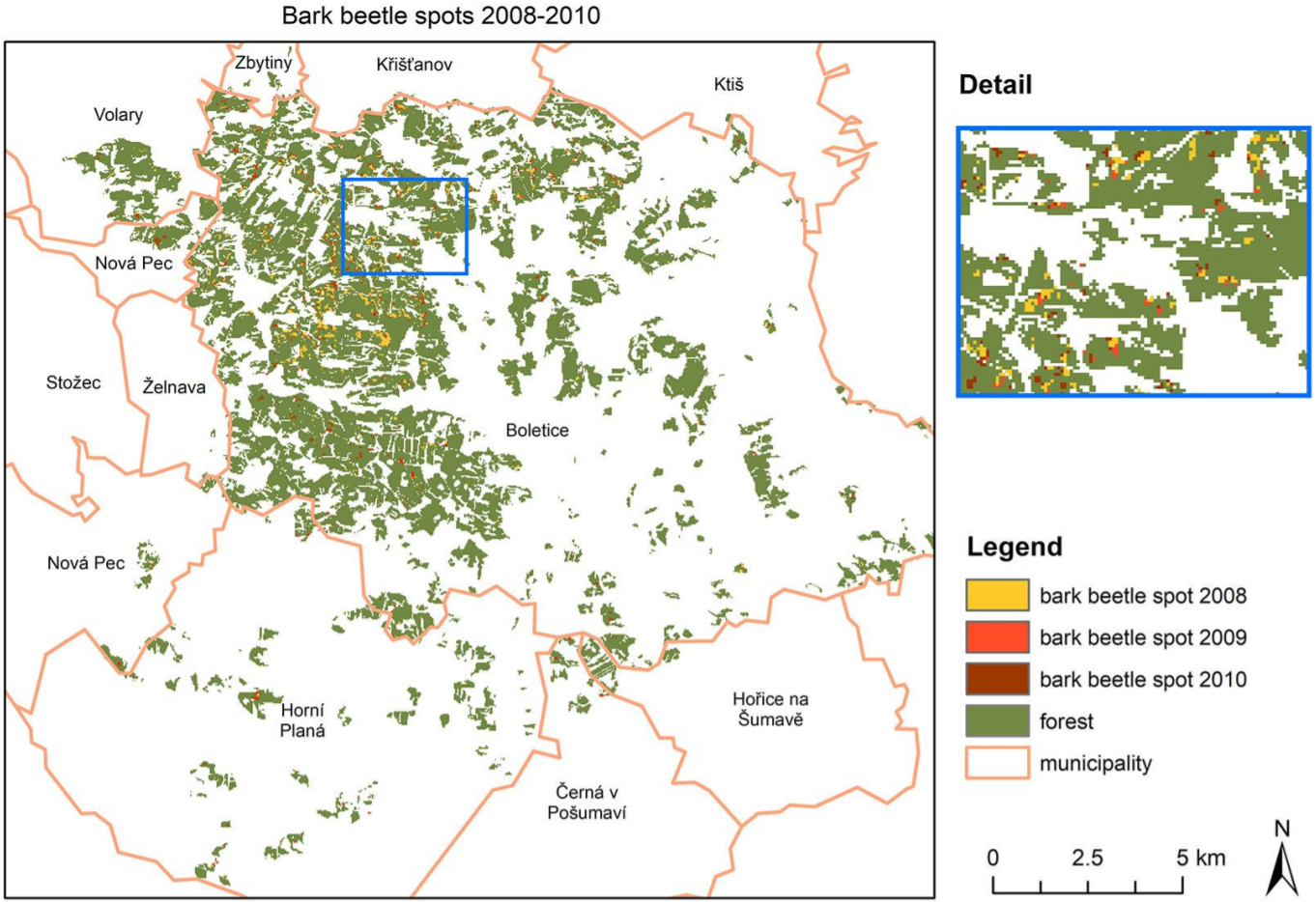 | Duračiová, Renata; Muňko, Milan; Barka, Ivan; Koreň, Milan; Resnerová, Karolina; Holuša, Jaroslav; Blaženec, Miroslav; Potterf, Mária; Jakuš, Rastislav A bark beetle infestation predictive model based on satellite data in the frame of decision support system TANABBO Journal Article iFOREST, 13 (3), pp. 215-223, 2020, ISSN: 1971-7458. Abstract | Links | BibTeX @article{Duračiová2020,
title = {A bark beetle infestation predictive model based on satellite data in the frame of decision support system TANABBO},
author = {Renata Duračiová and Milan Muňko and Ivan Barka and Milan Koreň and Karolina Resnerová and Jaroslav Holuša and Miroslav Blaženec and Mária Potterf and Rastislav Jakuš},
doi = {10.3832/ifor3271-013},
issn = {1971-7458},
year = {2020},
date = {2020-06-06},
journal = {iFOREST},
volume = {13},
number = {3},
pages = {215-223},
abstract = {The European spruce bark beetle Ips typographus L. causes significant economic losses in managed coniferous forests in Central and Northern Europe. New infestations either occur in previously undisturbed forest stands (i.e., spot initiation) or depend on proximity to previous years’ infestations (i.e., spot spreading). Early identification of newly infested trees over the forested landscape limits the effective control measures. Accurate forecasting of the spread of bark beetle infestation is crucial to plan efficient sanitation felling of infested trees and prevent further propagation of beetle-induced tree mortality. We created a predictive model of subsequent year spot initiation and spot spreading within the TANABBO decision support system. The algorithm combines open-access Landsat-based vegetation change time-series data, a digital terrain model, and forest stand characteristics. We validated predicted susceptibility to bark beetle attack (separately for spot initiation and spot spreading) against beetle infestations in managed forests in the Bohemian Forest in the Czech Republic (Central Europe) in yearly time steps from 2007 to 2010. The predictive models of susceptibility to bark beetle attack had a high degree of reliability (area under the ROC curve - AUC: 0.75-0.82). We conclude that spot initiation and spot spreading prediction modules included within the TANABBO model have the potential to help forest managers to plan sanitation felling in managed forests under pressure of bark beetle outbreak.},
keywords = {},
pubstate = {published},
tppubtype = {article}
}
The European spruce bark beetle Ips typographus L. causes significant economic losses in managed coniferous forests in Central and Northern Europe. New infestations either occur in previously undisturbed forest stands (i.e., spot initiation) or depend on proximity to previous years’ infestations (i.e., spot spreading). Early identification of newly infested trees over the forested landscape limits the effective control measures. Accurate forecasting of the spread of bark beetle infestation is crucial to plan efficient sanitation felling of infested trees and prevent further propagation of beetle-induced tree mortality. We created a predictive model of subsequent year spot initiation and spot spreading within the TANABBO decision support system. The algorithm combines open-access Landsat-based vegetation change time-series data, a digital terrain model, and forest stand characteristics. We validated predicted susceptibility to bark beetle attack (separately for spot initiation and spot spreading) against beetle infestations in managed forests in the Bohemian Forest in the Czech Republic (Central Europe) in yearly time steps from 2007 to 2010. The predictive models of susceptibility to bark beetle attack had a high degree of reliability (area under the ROC curve - AUC: 0.75-0.82). We conclude that spot initiation and spot spreading prediction modules included within the TANABBO model have the potential to help forest managers to plan sanitation felling in managed forests under pressure of bark beetle outbreak. |
2019
|
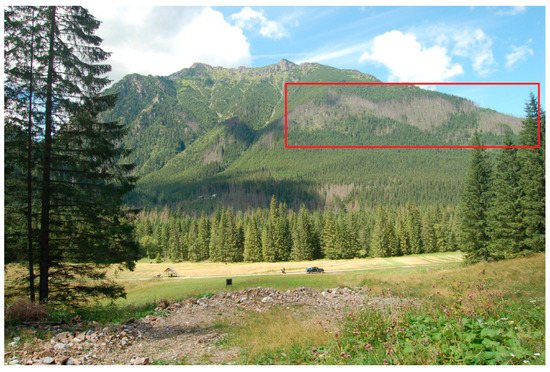 | Mezei, Pavel; Potterf, Mária; Škvarenina, Jaroslav; Rasmussen, Jakob Gulddahl; Jakuš, Rastislav Potential Solar Radiation as a Driver for Bark Beetle Infestation on a Landscape Scale Journal Article Forests, 10 (7), 2019, ISSN: 1999-4907. Abstract | Links | BibTeX @article{Mezei2019,
title = {Potential Solar Radiation as a Driver for Bark Beetle Infestation on a Landscape Scale},
author = {Pavel Mezei and Mária Potterf and Jaroslav Škvarenina and Jakob Gulddahl Rasmussen and Rastislav Jakuš},
doi = {10.3390/f10070604},
issn = {1999-4907},
year = {2019},
date = {2019-07-19},
journal = {Forests},
volume = {10},
number = {7},
abstract = {In recent decades, Norway spruce (Picea abies L. Karst.) forests of the High Tatra Mountains have suffered unprecedented tree mortality caused by European spruce bark beetle (Ips typographus L.). Analysis of the spatiotemporal pattern of bark beetle outbreaks across the landscape in consecutive years can provide new insights into the population dynamics of tree-killing insects. A bark beetle outbreak occurred in the High Tatra Mountains after a storm damaged more than 10,000 ha of forests in 2004. We combined yearly Landsat-derived bark beetle infestation spots from 2006 to 2014 and meteorological data to identify the susceptibility of forest stands to beetle infestation. We found that digital elevation model (DEM)-derived potential radiation loads predicted beetle infestation, especially in the peak phase of beetle epidemic. Moreover, spots attacked at the beginning of our study period had higher values of received solar radiation than spots at the end of the study period, indicating that bark beetles prefer sites with higher insolation during outbreak. We conclude that solar radiation, easily determined from the DEM, better identified beetle infestations than commonly used meteorological variables. We recommend including potential solar radiation in beetle infestation prediction models. },
keywords = {},
pubstate = {published},
tppubtype = {article}
}
In recent decades, Norway spruce (Picea abies L. Karst.) forests of the High Tatra Mountains have suffered unprecedented tree mortality caused by European spruce bark beetle (Ips typographus L.). Analysis of the spatiotemporal pattern of bark beetle outbreaks across the landscape in consecutive years can provide new insights into the population dynamics of tree-killing insects. A bark beetle outbreak occurred in the High Tatra Mountains after a storm damaged more than 10,000 ha of forests in 2004. We combined yearly Landsat-derived bark beetle infestation spots from 2006 to 2014 and meteorological data to identify the susceptibility of forest stands to beetle infestation. We found that digital elevation model (DEM)-derived potential radiation loads predicted beetle infestation, especially in the peak phase of beetle epidemic. Moreover, spots attacked at the beginning of our study period had higher values of received solar radiation than spots at the end of the study period, indicating that bark beetles prefer sites with higher insolation during outbreak. We conclude that solar radiation, easily determined from the DEM, better identified beetle infestations than commonly used meteorological variables. We recommend including potential solar radiation in beetle infestation prediction models. |
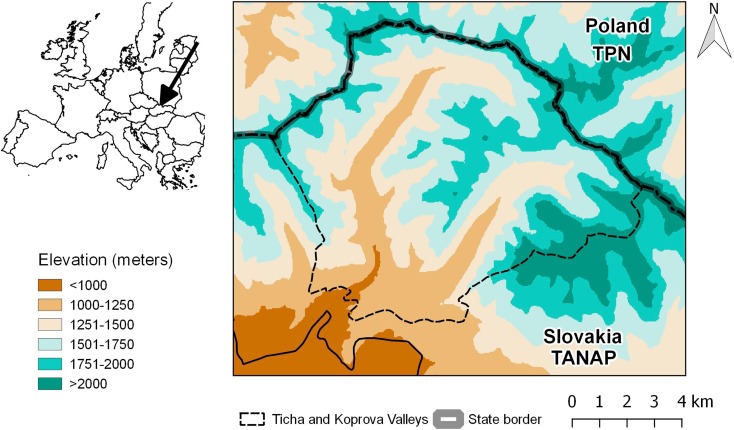 | Potterf, Mária; Nikolov, Christo; Kočická, Erika; Ferenčík, Ján; Mezei, Pavel; Jakuš, Rastislav Landscape-level spread of beetle infestations from windthrown- and beetle-killed trees in the non-intervention zone of the Tatra National Park, Slovakia (Central Europe) Journal Article Forest Ecology and Management, 432 , pp. 489-500, 2019, ISSN: 0378-1127. Links | BibTeX @article{Potterf2019,
title = {Landscape-level spread of beetle infestations from windthrown- and beetle-killed trees in the non-intervention zone of the Tatra National Park, Slovakia (Central Europe)},
author = {Mária Potterf and Christo Nikolov and Erika Kočická and Ján Ferenčík and Pavel Mezei and Rastislav Jakuš},
doi = {10.1016/j.foreco.2018.09.050},
issn = {0378-1127},
year = {2019},
date = {2019-01-15},
journal = {Forest Ecology and Management},
volume = {432},
pages = {489-500},
keywords = {},
pubstate = {published},
tppubtype = {article}
}
|
2017
|
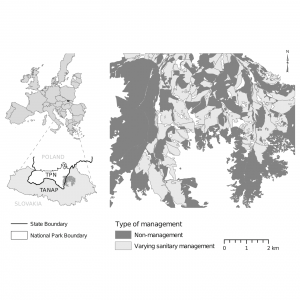 | Mezei, Pavel; Blaženec, Miroslav; Grodzki, Wojciech; Škvarenina, Jaroslav; Jakuš, Rastislav Influence of different forest protection strategies on spruce tree mortality during a bark beetle outbreak Journal Article Annals of Forest Science, 74 , 2017, ISSN: 1297-966X. Links | BibTeX @article{Mezei2017b,
title = {Influence of different forest protection strategies on spruce tree mortality during a bark beetle outbreak},
author = {Pavel Mezei and Miroslav Blaženec and Wojciech Grodzki and Jaroslav Škvarenina and Rastislav Jakuš},
url = {http://rdcu.be/wnGe},
doi = {doi.org/10.1007/s13595-017-0663-9},
issn = {1297-966X},
year = {2017},
date = {2017-09-27},
journal = {Annals of Forest Science},
volume = {74},
keywords = {},
pubstate = {published},
tppubtype = {article}
}
|
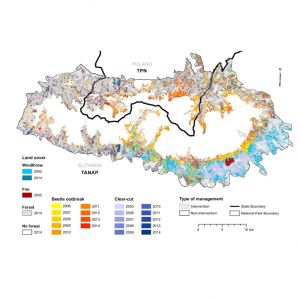 | Havašová, M; Ferenčík, J; Jakuš, R Interactions between windthrow, bark beetles and forest management in the Tatra national parks Journal Article Forest Ecology and Management, 391 , pp. 349-361, 2017, ISSN: 03781127. Abstract | Links | BibTeX @article{M.2017,
title = {Interactions between windthrow, bark beetles and forest management in the Tatra national parks},
author = {M. Havašová and J. Ferenčík and R. Jakuš},
url = {http://www.sciencedirect.com/science/article/pii/S0378112717300361},
doi = {https://doi.org/10.1016/j.foreco.2017.01.009},
issn = {03781127},
year = {2017},
date = {2017-05-01},
journal = {Forest Ecology and Management},
volume = {391},
pages = {349-361},
abstract = {Natural disturbances such as windthrow and bark beetle Ips typographus L. outbreak often affect protected areas with non-intervention type of management located in close proximity to managed forest stands. This raises concerns about the migration of the beetle outbreak from non-intervention zones to adjacent managed forests. In this study we analyzed the spatiotemporal dynamics of large-scale disturbances by intervention and non-intervention type of management in the Tatra mountains (Central Europe). We collected a time series of Landsat images from 2003 to 2014, and applied maximum likelihood classification to map the extent of forest, windthrow, clear-cuts, beetle outbreak and fire. Our classified maps achieved high overall accuracies: 0.93 ± 0.03 ≤ OA ≤ 0.96 ± 0.03. The extent of forest declined over the study period. We found higher rate of beetle induced tree mortality in non-intervention versus intervention zone. Within two growing seasons after the windthrow, beetle infestation occurred in close proximity to uncleared windthrow (< ~ 250 m), which suggest the positive effect of salvage logging (removal of windthrown trees) on lowering the risk of beetle outbreak. The two times higher sum of disturbances in intervention then in non-intervention zone indicated the limited impact of sanitation felling (removal of standing beetle infested trees) to reduce beetle population. However, sanitation felling highly contributed to the decline of the forest cover. Overall, our results document the dynamics of windthrow, bark beetle and clear-cuts by type of management, and limited impact of logging activities in reducing beetle outbreak in neighboring areas with intervention and non-intervention type of management.},
keywords = {},
pubstate = {published},
tppubtype = {article}
}
Natural disturbances such as windthrow and bark beetle Ips typographus L. outbreak often affect protected areas with non-intervention type of management located in close proximity to managed forest stands. This raises concerns about the migration of the beetle outbreak from non-intervention zones to adjacent managed forests. In this study we analyzed the spatiotemporal dynamics of large-scale disturbances by intervention and non-intervention type of management in the Tatra mountains (Central Europe). We collected a time series of Landsat images from 2003 to 2014, and applied maximum likelihood classification to map the extent of forest, windthrow, clear-cuts, beetle outbreak and fire. Our classified maps achieved high overall accuracies: 0.93 ± 0.03 ≤ OA ≤ 0.96 ± 0.03. The extent of forest declined over the study period. We found higher rate of beetle induced tree mortality in non-intervention versus intervention zone. Within two growing seasons after the windthrow, beetle infestation occurred in close proximity to uncleared windthrow (< ~ 250 m), which suggest the positive effect of salvage logging (removal of windthrown trees) on lowering the risk of beetle outbreak. The two times higher sum of disturbances in intervention then in non-intervention zone indicated the limited impact of sanitation felling (removal of standing beetle infested trees) to reduce beetle population. However, sanitation felling highly contributed to the decline of the forest cover. Overall, our results document the dynamics of windthrow, bark beetle and clear-cuts by type of management, and limited impact of logging activities in reducing beetle outbreak in neighboring areas with intervention and non-intervention type of management. |
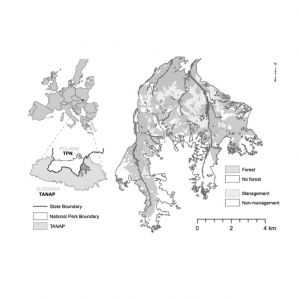 | Mezei, P; Jakuš, R; Pennerstorfer, J; Havašová, M; Škvarenina, J; Ferenčík, J; Slivinský, J; Bičárová, S; Bilčík, D; Blaženec, M; Netherer, S Storms, temperature maxima and the Eurasian spruce bark beetle Ips typographus — an infernal trio in Norway spruce forests of the Central European High Tatra Mountains Journal Article Agricultural and Forest Meteorology, 242 , pp. 85-95, 2017. Abstract | Links | BibTeX @article{Mezei2017,
title = {Storms, temperature maxima and the Eurasian spruce bark beetle \textit{Ips typographus} — an infernal trio in Norway spruce forests of the Central European High Tatra Mountains},
author = {P. Mezei and R. Jakuš and J. Pennerstorfer and M. Havašová and J. Škvarenina and J. Ferenčík and J. Slivinský and S. Bičárová and D. Bilčík and M. Blaženec and S. Netherer},
url = {http://ife.sk/wp-content/uploads/2016/10/Figure_4_20170406_2-pdf-300x192.jpghttp://www.sciencedirect.com/science/article/pii/S0168192317301326},
doi = {10.1016/j.agrformet.2017.04.004},
year = {2017},
date = {2017-04-10},
journal = { Agricultural and Forest Meteorology},
volume = {242},
pages = {85-95},
abstract = {Norway spruce forests (Picea abies Karst.) of the Carpathian High Tatra Mountains have been subject to unprecedented tree mortality caused by attacks of the Eurasian spruce bark beetle (Ips typographus L.) in recent decades. The outbreaks were preceded and accompanied by wind throw events and periods of increased seasonal temperature. We obtained climatic data and data on tree mortality due to storm throw and bark beetles by using a combination of direct dead tree inventory and remote sensing techniques, and examined annual tree loss change over a 26-year period in a forest district of the Slovak High Tatra National Park. In particular, we found that the combination of the previous year's maximum daily temperature sum, tree mortality caused by wind, and bark beetle-caused tree mortality best explained the annual tree loss change in nonlinear regression models. The number of trees infested by bark beetles clearly increased with maximum air temperature sums ranging from 2850 to 3150 ° days, but declined below or above this thermal optimum. Annual tree mortality clearly increased subsequent to years associated with seasonal temperature sums allowing for the development of sister broods. Given consistently favourable future climatic conditions for development of I. typographus populations in the study area, a possible shift from the now predominantly uni-voltine to multi-voltine bark beetle populations might increase attack pressure also at high elevation sites.},
keywords = {},
pubstate = {published},
tppubtype = {article}
}
Norway spruce forests (Picea abies Karst.) of the Carpathian High Tatra Mountains have been subject to unprecedented tree mortality caused by attacks of the Eurasian spruce bark beetle (Ips typographus L.) in recent decades. The outbreaks were preceded and accompanied by wind throw events and periods of increased seasonal temperature. We obtained climatic data and data on tree mortality due to storm throw and bark beetles by using a combination of direct dead tree inventory and remote sensing techniques, and examined annual tree loss change over a 26-year period in a forest district of the Slovak High Tatra National Park. In particular, we found that the combination of the previous year's maximum daily temperature sum, tree mortality caused by wind, and bark beetle-caused tree mortality best explained the annual tree loss change in nonlinear regression models. The number of trees infested by bark beetles clearly increased with maximum air temperature sums ranging from 2850 to 3150 ° days, but declined below or above this thermal optimum. Annual tree mortality clearly increased subsequent to years associated with seasonal temperature sums allowing for the development of sister broods. Given consistently favourable future climatic conditions for development of I. typographus populations in the study area, a possible shift from the now predominantly uni-voltine to multi-voltine bark beetle populations might increase attack pressure also at high elevation sites. |
![TANABBO II model pro hodnocení rizika napadení lesních porostů lýkožroutem smrkovým Ips typographus (L.) [Coleoptera: Curculionidae]](http://ife.sk/wp-content/uploads/2020/09/jakus_2007.png) | Jakuš, Rastislav; Blaženec, Miroslav; doc. Koreň, Mgr. Milan; Barka, Ivan; Lukášová, Karolina; Lubojacký, Jan; Holuša, Jaroslav TANABBO II model pro hodnocení rizika napadení lesních porostů lýkožroutem smrkovým Ips typographus (L.) [Coleoptera: Curculionidae] Book 1/2017, Výzkumný ústav lesního hospodářství a myslivosti, 2017. BibTeX @book{Jakuš2017,
title = {TANABBO II model pro hodnocení rizika napadení lesních porostů lýkožroutem smrkovým \textit{Ips typographus} (L.) [Coleoptera: Curculionidae]},
author = {Rastislav Jakuš and Miroslav Blaženec and doc. Mgr. Milan Koreň and Ivan Barka and Karolina Lukášová and Jan Lubojacký and Jaroslav Holuša},
year = {2017},
date = {2017-01-01},
publisher = {Výzkumný ústav lesního hospodářství a myslivosti},
edition = {1/2017},
keywords = {},
pubstate = {published},
tppubtype = {book}
}
|
2016
|
 | Chalachanová, Jana Faixová; Ďuračiová, Renata; Papčo, Juraj; Jakuš, Rastislav; Blaženec, Miroslav Integration of Heterogeneous Data in the Support of the Forest Protection: Structural Concept Journal Article Lecture Notes in Geoinformation and Cartography, pp. 387-405, 2016, ISSN: 1863-2246. Abstract | Links | BibTeX @article{Chalachanová2016,
title = {Integration of Heterogeneous Data in the Support of the Forest Protection: Structural Concept},
author = {Jana Faixová Chalachanová and Renata Ďuračiová and Juraj Papčo and Rastislav Jakuš and Miroslav Blaženec},
doi = {10.1007/978-3-319-45123-7_28},
issn = {1863-2246},
year = {2016},
date = {2016-10-15},
journal = {Lecture Notes in Geoinformation and Cartography},
pages = {387-405},
abstract = {The basic precondition for effective management and protection of a forest is a concept built on modern methods of collection, processing, analysis and publication of spatial data about forest coverage, as well as its health status. This paper provides a structural concept for integration of heterogeneous data in the support of the forest protection with implementation of the latest methods of remote sensing data collection. The main principles of the structural concept of Forest protection management system (FPMS) result from the assessment of the current and new available data sources (represented by the Diagram of data sources), data analysis and development of innovative mathematical techniques of image processing (represented by the Diagram of methods and tools). Mind maps of the proposed diagrams were created in the free mind mapping application FreeMind. The structural concept is represented by an analytical model of the co-operation of data sources, tools and applications. The dynamic structure was proposed using Unified Modelling Language (UML). The Diagram of the use cases is represented by a Use Case Diagram in UML. The Diagram of the processes, which describes the main processes realized within forest protection management, is represented by an Activity Diagram in UML. The UML diagrams were created in open-source software StarUML. The resulted structural concept of FPMS is the basis of a predictive model improvement and a web application development for the forest protection from the bark beetle.},
keywords = {},
pubstate = {published},
tppubtype = {article}
}
The basic precondition for effective management and protection of a forest is a concept built on modern methods of collection, processing, analysis and publication of spatial data about forest coverage, as well as its health status. This paper provides a structural concept for integration of heterogeneous data in the support of the forest protection with implementation of the latest methods of remote sensing data collection. The main principles of the structural concept of Forest protection management system (FPMS) result from the assessment of the current and new available data sources (represented by the Diagram of data sources), data analysis and development of innovative mathematical techniques of image processing (represented by the Diagram of methods and tools). Mind maps of the proposed diagrams were created in the free mind mapping application FreeMind. The structural concept is represented by an analytical model of the co-operation of data sources, tools and applications. The dynamic structure was proposed using Unified Modelling Language (UML). The Diagram of the use cases is represented by a Use Case Diagram in UML. The Diagram of the processes, which describes the main processes realized within forest protection management, is represented by an Activity Diagram in UML. The UML diagrams were created in open-source software StarUML. The resulted structural concept of FPMS is the basis of a predictive model improvement and a web application development for the forest protection from the bark beetle. |
2015
|
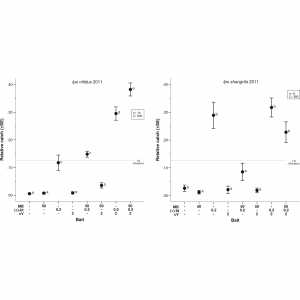 | Schlyter, F; Jakuš, R; Han, F Z; Kalinová, B; Mezei, P; Sun, J H; Ma, J H; Ujhelyiová, L; Zhang, Q H Reproductive isolation of Ips nitidus and I. shangrila in mountain forests of Western China: responses to chiral and achiral candidate pheromone components Journal Article Journal of Chemical Ecology, 41 (7), pp. 678-688, 2015. Links | BibTeX @article{F.2015,
title = {Reproductive isolation of \textit{Ips nitidus} and \textit{I. shangrila} in mountain forests of Western China: responses to chiral and achiral candidate pheromone components},
author = {F. Schlyter and R. Jakuš and F.Z. Han and B. Kalinová and P. Mezei and J.H. Sun and J.H. Ma and L. Ujhelyiová and Q.H. Zhang},
url = {https://www.ncbi.nlm.nih.gov/pubmed/26112107},
year = {2015},
date = {2015-07-01},
journal = {Journal of Chemical Ecology},
volume = {41},
number = {7},
pages = {678-688},
keywords = {},
pubstate = {published},
tppubtype = {article}
}
|
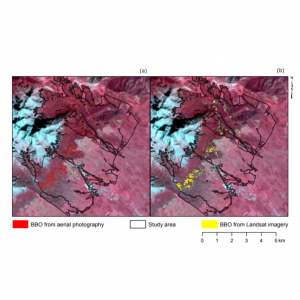 | Havašová, M; Bucha, T; Ferenčík, J; Jakuš, R Applicability of a vegetation indices-based method to map bark beetle outbreaks in the High Tatra Mountains Journal Article Annals of Forest Research, 58 (2), pp. 295-310, 2015. Abstract | Links | BibTeX @article{Havašová2015,
title = {Applicability of a vegetation indices-based method to map bark beetle outbreaks in the High Tatra Mountains},
author = {M. Havašová and T. Bucha and J. Ferenčík and R. Jakuš},
url = {http://afrjournal.org/index.php/afr/article/viewFile/388/466},
year = {2015},
date = {2015-05-18},
journal = {Annals of Forest Research},
volume = {58},
number = {2},
pages = {295-310},
abstract = {Automatic identification of forest patches disturbed by the spruce
bark beetle Ips typographus L. is crucial to reveal the rules of following
bark beetle outbreaks on the landscape scale. Landsat imagery provides
free resources to outline past and present gradations of bark beetle outbreaks
(BBOs). The objective of this study is to identify the most sensitive
vegetation index through different method of vegetation index differencing
to identify past and actual bark beetle outbreaks. Six Landsat Thematic
Mapper (TM) images, from 2005–2009 and 2011, were converted into selected
vegetation indices (VIs) sensitive to conifer tree health in a Norway
spruce–dominated forest in the High Tatra Mountains. The Vegetation Condition
Index (VCI), Moisture Stress Index (MSI), Normalised Difference
Moisture Index (NDMI), Normalised Difference Vegetation Index (NDVI),
Disturbance Index (DI) and Changed Disturbance Index (DI´) were calculated
separately for every year, and the methodology of vegetation index
differencing was applied to multiple two-year time periods (2005–2006,
2006–2007, 2007–2008, 2008–2009 and 2010–2011), thus producing the
Changed Vegetation Index (ΔVI). A set of thresholds was established on
ΔVI to classify disturbed and undisturbed forest due to BBOs; the sensitivity
of different VIs to identify BBO was equally evaluated. The highest
accuracies of classifications were reached in 2007 and 2011 (kappa index
of agreement >70% and >40%, respectively), which were characterised
by an epidemic phase of a BBO. All selected VIs were highly sensitive to
BBOs, except for NDVI. The stable threshold value for change detection
is not widely applicable to detect past forest disturbances caused by bark
beetles, however. Finally, for further research of the epidemic phases of
BBOs, we recommend the utilisation of the vegetation indices VCI, MSI and
NDMI to detect BBOs because of their simplicity and easy interpretability},
keywords = {},
pubstate = {published},
tppubtype = {article}
}
Automatic identification of forest patches disturbed by the spruce
bark beetle Ips typographus L. is crucial to reveal the rules of following
bark beetle outbreaks on the landscape scale. Landsat imagery provides
free resources to outline past and present gradations of bark beetle outbreaks
(BBOs). The objective of this study is to identify the most sensitive
vegetation index through different method of vegetation index differencing
to identify past and actual bark beetle outbreaks. Six Landsat Thematic
Mapper (TM) images, from 2005–2009 and 2011, were converted into selected
vegetation indices (VIs) sensitive to conifer tree health in a Norway
spruce–dominated forest in the High Tatra Mountains. The Vegetation Condition
Index (VCI), Moisture Stress Index (MSI), Normalised Difference
Moisture Index (NDMI), Normalised Difference Vegetation Index (NDVI),
Disturbance Index (DI) and Changed Disturbance Index (DI´) were calculated
separately for every year, and the methodology of vegetation index
differencing was applied to multiple two-year time periods (2005–2006,
2006–2007, 2007–2008, 2008–2009 and 2010–2011), thus producing the
Changed Vegetation Index (ΔVI). A set of thresholds was established on
ΔVI to classify disturbed and undisturbed forest due to BBOs; the sensitivity
of different VIs to identify BBO was equally evaluated. The highest
accuracies of classifications were reached in 2007 and 2011 (kappa index
of agreement >70% and >40%, respectively), which were characterised
by an epidemic phase of a BBO. All selected VIs were highly sensitive to
BBOs, except for NDVI. The stable threshold value for change detection
is not widely applicable to detect past forest disturbances caused by bark
beetles, however. Finally, for further research of the epidemic phases of
BBOs, we recommend the utilisation of the vegetation indices VCI, MSI and
NDMI to detect BBOs because of their simplicity and easy interpretability |
![Hodnotenie zdravotného stavu smreka vo vzťahu smreka k náletu podkôrneho hmyzu a k odumieraniu lesa [Evaluation of Norway spruce helath status in relationships with bark beetle outbreak and forest dying]](https://ife.sk/wp-content/uploads/2016/10/IFE_blazenec_02.png) | Jakuš, R; Cudlín, P; Slivinský, J; Mezei, P; Majdák, A; Blaženec, M Hodnotenie zdravotného stavu smreka vo vzťahu smreka k náletu podkôrneho hmyzu a k odumieraniu lesa [Evaluation of Norway spruce helath status in relationships with bark beetle outbreak and forest dying] Book Ústav ekológie lesa, Slovenská akadémia vied, Zvolen, 2015, ISBN: 978-80-89408-22-1. Links | BibTeX @book{Jakuš2015,
title = {Hodnotenie zdravotného stavu smreka vo vzťahu smreka k náletu podkôrneho hmyzu a k odumieraniu lesa [Evaluation of Norway spruce helath status in relationships with bark beetle outbreak and forest dying]},
author = {R. Jakuš and P. Cudlín and J. Slivinský and P. Mezei and A. Majdák and M. Blaženec},
url = {https://www.researchgate.net/publication/280014410_Hodnotenie_zdravotneho_stavu_smreka_vo_vztahu_k_naletu_podkorneho_hmyzu_a_k_odumieraniu_lesa},
isbn = {978-80-89408-22-1},
year = {2015},
date = {2015-01-01},
booktitle = {Prognosticko-informačné systémy pre zvýšenie efektívnosti manažmentu lesa},
publisher = {Ústav ekológie lesa, Slovenská akadémia vied},
address = {Zvolen},
keywords = {},
pubstate = {published},
tppubtype = {book}
}
|
![Princípy ochrany dospelých smrekových porastov pred podkôrnym hmyzom [Conservation principles of mature Norway spruce trees attacked by bark beetles]](https://ife.sk/wp-content/uploads/2016/10/IFE_blazenec_03.png) | Jakuš, R; Blaženec, M; Gurtsev, A I; Holuša, J; Hroššo, B; Křenová, Z; Longauerová, V; Lukášová, K; Majdák, A; Mezei, P; Slivinský, J Princípy ochrany dospelých smrekových porastov pred podkôrnym hmyzom [Conservation principles of mature Norway spruce trees attacked by bark beetles] Book Ústav ekológie lesa, Slovenská akadémia vied, Zvolen, 2015, ISBN: 978-80-89408-21-4. Links | BibTeX @book{Jakuš2015b,
title = {Princípy ochrany dospelých smrekových porastov pred podkôrnym hmyzom [Conservation principles of mature Norway spruce trees attacked by bark beetles]},
author = {R. Jakuš and M. Blaženec and A.I. Gurtsev and J. Holuša and B. Hroššo and Z. Křenová and V. Longauerová and K. Lukášová and A. Majdák and P. Mezei and J. Slivinský},
editor = {R. Jakuš and M. Blaženec},
url = {https://www.researchgate.net/publication/280883448_Principy_ochrany_dospelych_smrekovych_porastov_pred_podkornym_hmyzom},
isbn = {978-80-89408-21-4},
year = {2015},
date = {2015-01-01},
booktitle = {Prognosticko-informačné systémy pre zvýšenie efektívnosti manažmentu lesa},
publisher = {Ústav ekológie lesa, Slovenská akadémia vied},
address = {Zvolen},
keywords = {},
pubstate = {published},
tppubtype = {book}
}
|
2014
|
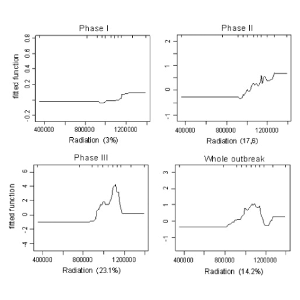 | Mezei, P; Grodzki, W; Blaženec, M; Škvarenina, J; Brandýsová, V; Jakuš, R Host and site factors affecting tree mortality caused by the spruce bark beetle (Ips typographus) in mountainous conditions Journal Article Forest Ecology and Management, 331 , pp. 196–207, 2014. Links | BibTeX @article{P.2014b,
title = {Host and site factors affecting tree mortality caused by the spruce bark beetle (\textit{Ips typographus}) in mountainous conditions},
author = {P. Mezei and W. Grodzki and M. Blaženec and J. Škvarenina and V. Brandýsová and R. Jakuš},
url = {http://www.sciencedirect.com/science/article/pii/S0378112714004691},
year = {2014},
date = {2014-11-01},
journal = {Forest Ecology and Management},
volume = {331},
pages = {196–207},
keywords = {},
pubstate = {published},
tppubtype = {article}
}
|
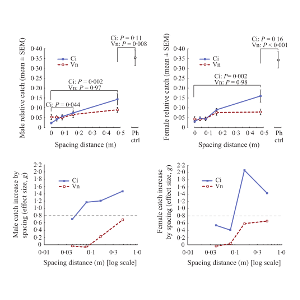 | Binyameen, M; Jankuvová, J; Blaženec, M; Jakuš, R; Song, L; Schlyter, F; Andersson, M N Co-localization of insect olfactory sensory cells improves the discrimination of closely separated odour sources Journal Article Functional Ecology, 28 (5), pp. 1216–1223, 2014. Links | BibTeX @article{M.2014,
title = {Co-localization of insect olfactory sensory cells improves the discrimination of closely separated odour sources},
author = {M. Binyameen and J. Jankuvová and M. Blaženec and R. Jakuš and L. Song and F. Schlyter and M.N. Andersson},
url = {http://onlinelibrary.wiley.com/doi/10.1111/1365-2435.12252/abstract},
year = {2014},
date = {2014-03-03},
journal = {Functional Ecology},
volume = {28},
number = {5},
pages = {1216–1223},
keywords = {},
pubstate = {published},
tppubtype = {article}
}
|
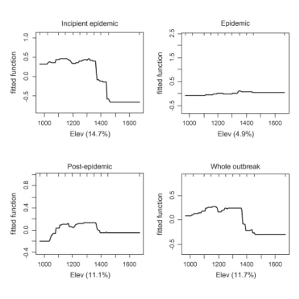 | Mezei, P; Grodzki, W; Blaženec, M; Jakuš, R Factors influencing the wind-bark beetles’ disturbance system in the course of an Ips typographus outbreak in the Tatra Mountains Journal Article Forest Ecology and Management, 312 , pp. 67–77, 2014. Links | BibTeX @article{P.2014b,
title = {Factors influencing the wind-bark beetles’ disturbance system in the course of an \textit{Ips typographus} outbreak in the Tatra Mountains},
author = {P. Mezei and W. Grodzki and M. Blaženec and R. Jakuš},
url = {http://www.sciencedirect.com/science/article/pii/S0378112713006877},
year = {2014},
date = {2014-01-01},
journal = {Forest Ecology and Management},
volume = {312},
pages = {67–77},
keywords = {},
pubstate = {published},
tppubtype = {article}
}
|
2012
|
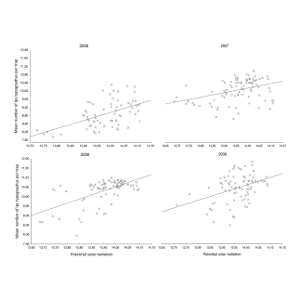 | Mezei, P; Jakuš, R; Blaženec, M; Belánová, S; Šmídt, J The relationship between potential solar radiation and spruce bark beetle catches in pheromone traps Journal Article Annals of Forest Research, 55 (2), pp. 243-252, 2012, ISSN: 18448135. Abstract | BibTeX @article{Mezei2012,
title = {The relationship between potential solar radiation and spruce bark beetle catches in pheromone traps},
author = {P. Mezei and R. Jakuš and M. Blaženec and S. Belánová and J. Šmídt},
issn = {18448135},
year = {2012},
date = {2012-01-01},
journal = {Annals of Forest Research},
volume = {55},
number = {2},
pages = {243-252},
abstract = {We analysed the relationship between the amount of potential solar radiation and spruce bark beetle Ips typographus(L.) catches in pheromone traps in an unmanaged nature reserve in the Carpathians (middle Slovakia region), from 2006 through 2009. This relationship was analysed under outbreak conditions. The number of traps varied in different years from 70 to 92. The traps were installed in spruce-forest-dominated stands affected by a windstorm in 2004. A GPS device was used to mark the position of the pheromone traps. The potential solar radiation was calculated with GIS tools for three different time periods in each year: with entire year, for main flight season of the spruce bark beetle and the spring swarming period. The relationship between the amount of potential solar radiation and the spruce bark beetle catches was statistically significant for each year and each time period except for the spring swarming in 2007, when the pheromone traps were not set up on time.},
keywords = {},
pubstate = {published},
tppubtype = {article}
}
We analysed the relationship between the amount of potential solar radiation and spruce bark beetle Ips typographus(L.) catches in pheromone traps in an unmanaged nature reserve in the Carpathians (middle Slovakia region), from 2006 through 2009. This relationship was analysed under outbreak conditions. The number of traps varied in different years from 70 to 92. The traps were installed in spruce-forest-dominated stands affected by a windstorm in 2004. A GPS device was used to mark the position of the pheromone traps. The potential solar radiation was calculated with GIS tools for three different time periods in each year: with entire year, for main flight season of the spruce bark beetle and the spring swarming period. The relationship between the amount of potential solar radiation and the spruce bark beetle catches was statistically significant for each year and each time period except for the spring swarming in 2007, when the pheromone traps were not set up on time. |
2011
|
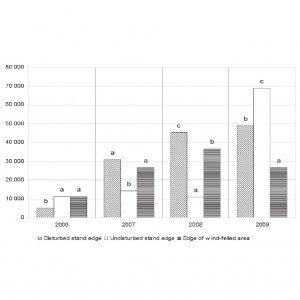 | Mezei, P; Jakuš, R; Blaženec, M; Belánová, S; Šmídt, J Population dynamics of spruce bark beetle in a nature reserve in relation to stand edges conditions Journal Article Folia Oecologica, 38 (1), pp. 73-79, 2011, ISSN: 13365266. Abstract | BibTeX @article{Mezei2011,
title = {Population dynamics of spruce bark beetle in a nature reserve in relation to stand edges conditions},
author = {P. Mezei and R. Jakuš and M. Blaženec and S. Belánová and J. Šmídt},
issn = {13365266},
year = {2011},
date = {2011-01-01},
journal = {Folia Oecologica},
volume = {38},
number = {1},
pages = {73-79},
abstract = {Over the period 2006–2009 spruce bark beetle (Ips typographus [L.]) population was monitored
after two windstorm events in a nature reserve in Slovak Ore Mountains. The monitoring was carried out with pheromone traps in three different forest edges: 1) edge of wind-felled trees area, 2)
disturbed stand edge and 3) undisturbed stand edge. The one-way ANOVAconfirmed statistically
significant differences among stand edges in each year and a post-hoc test was applied. In first
two years after the primary disturbance the most attractive for spruce bark beetle was the edge of
wind-felled trees area. After two years from the primary disturbance the most attractive became
the disturbed stand edge. The undisturbed stand edge showed a similar attractivity for spruce bark
beetles almost over the whole monitoring period.},
keywords = {},
pubstate = {published},
tppubtype = {article}
}
Over the period 2006–2009 spruce bark beetle (Ips typographus [L.]) population was monitored
after two windstorm events in a nature reserve in Slovak Ore Mountains. The monitoring was carried out with pheromone traps in three different forest edges: 1) edge of wind-felled trees area, 2)
disturbed stand edge and 3) undisturbed stand edge. The one-way ANOVAconfirmed statistically
significant differences among stand edges in each year and a post-hoc test was applied. In first
two years after the primary disturbance the most attractive for spruce bark beetle was the edge of
wind-felled trees area. After two years from the primary disturbance the most attractive became
the disturbed stand edge. The undisturbed stand edge showed a similar attractivity for spruce bark
beetles almost over the whole monitoring period. |
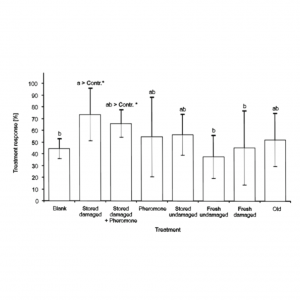 | Jakuš, R; Blaženec, M Response of walking spruce bark beetles Ips typographus to host odours Journal Article Folia Oecologica, 38 (1), pp. 38-45, 2011, ISSN: 1336-5266. Abstract | Links | BibTeX @article{Jakuš2011,
title = {Response of walking spruce bark beetles Ips typographus to host odours},
author = {R. Jakuš and M. Blaženec},
url = {http://ife.sk/wp-content/uploads/2016/10/5.pdf},
issn = {1336-5266},
year = {2011},
date = {2011-01-01},
journal = {Folia Oecologica},
volume = {38},
number = {1},
pages = {38-45},
abstract = {A two-choice walking bioassay olfactometer was used to asses the response of walking Ips typographus (L.) towards the odours from logs of Norway spruce (Picea abies [L.] Karst.) subjected to various treatments. The odour coming from fresh log from standing, unstressed trunk was unattractive or slightly repellent to males over clean air in bioassay. The same odour was neutral or slightly attractive to females. Storing of a log for one month led to increased attractiveness to both sexes. The odour from log after bark beetle breeding was slightly more attractive to both sexes over clean air, excepting very low level of source contact in males. Results on overall attraction are more unclear for females. The level of source contact was the main difference between the males and females. The females manifested higher levels of source contact than males.},
keywords = {},
pubstate = {published},
tppubtype = {article}
}
A two-choice walking bioassay olfactometer was used to asses the response of walking Ips typographus (L.) towards the odours from logs of Norway spruce (Picea abies [L.] Karst.) subjected to various treatments. The odour coming from fresh log from standing, unstressed trunk was unattractive or slightly repellent to males over clean air in bioassay. The same odour was neutral or slightly attractive to females. Storing of a log for one month led to increased attractiveness to both sexes. The odour from log after bark beetle breeding was slightly more attractive to both sexes over clean air, excepting very low level of source contact in males. Results on overall attraction are more unclear for females. The level of source contact was the main difference between the males and females. The females manifested higher levels of source contact than males. |
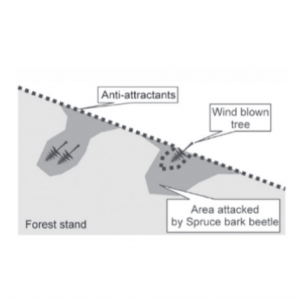 | Jakuš, R; Blaženec, M; Vojtěch, O Use of anti-attractants in specific conditions of protected areas Journal Article Folia Oecologica, 38 (1), pp. 46-51, 2011, ISSN: 1336-5266. Abstract | Links | BibTeX @article{Jakuš2011b,
title = {Use of anti-attractants in specific conditions of protected areas},
author = {R. Jakuš and M. Blaženec and O. Vojtěch},
url = {http://ife.sk/wp-content/uploads/2016/10/6.pdf},
issn = {1336-5266},
year = {2011},
date = {2011-01-01},
journal = {Folia Oecologica},
volume = {38},
number = {1},
pages = {46-51},
abstract = {Tests for protection of spruce forest stands against spruce bark beetle (Ips typographus) by using anti-attractants were performed in specific conditions of protected areas in which standard sanitary cutting is not allowed. The experiments have shown that application of anti-attractants in a no-cutting zone can significantly reduce bark beetle attacks on the standing trees. In case when the trees at stand edges are not damaged by wind, there is possible to reduce the tree mortality by up to 73%, even in case of large bark beetle populations and even in living green trees growing immediately next to trees attacked by spruce bark beetle. On the other hand, anti-attractants are ineffective at stand edge segments either damaged by freshly wind-thrown or broken trees or wedged with wind-thrown areas, as it was shown in semi-application tests in the NP šumava.},
keywords = {},
pubstate = {published},
tppubtype = {article}
}
Tests for protection of spruce forest stands against spruce bark beetle (Ips typographus) by using anti-attractants were performed in specific conditions of protected areas in which standard sanitary cutting is not allowed. The experiments have shown that application of anti-attractants in a no-cutting zone can significantly reduce bark beetle attacks on the standing trees. In case when the trees at stand edges are not damaged by wind, there is possible to reduce the tree mortality by up to 73%, even in case of large bark beetle populations and even in living green trees growing immediately next to trees attacked by spruce bark beetle. On the other hand, anti-attractants are ineffective at stand edge segments either damaged by freshly wind-thrown or broken trees or wedged with wind-thrown areas, as it was shown in semi-application tests in the NP šumava. |










![TANABBO II model pro hodnocení rizika napadení lesních porostů lýkožroutem smrkovým Ips typographus (L.) [Coleoptera: Curculionidae]](http://ife.sk/wp-content/uploads/2020/09/jakus_2007.png)


![Hodnotenie zdravotného stavu smreka vo vzťahu smreka k náletu podkôrneho hmyzu a k odumieraniu lesa [Evaluation of Norway spruce helath status in relationships with bark beetle outbreak and forest dying]](https://ife.sk/wp-content/uploads/2016/10/IFE_blazenec_02.png)
![Princípy ochrany dospelých smrekových porastov pred podkôrnym hmyzom [Conservation principles of mature Norway spruce trees attacked by bark beetles]](https://ife.sk/wp-content/uploads/2016/10/IFE_blazenec_03.png)







